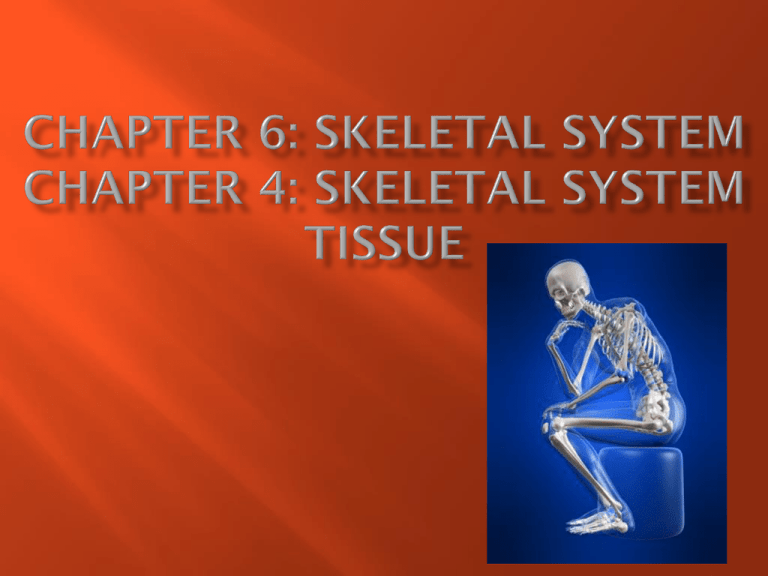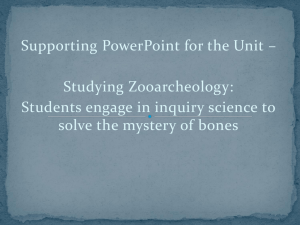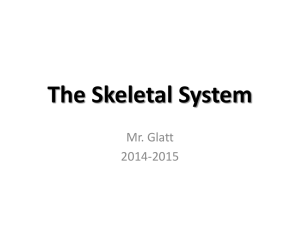
Skeletal
Discuss the functions of the skeletal system.
Classify bone in the basis of their shape and location.
Describe parts of long bone.
Describe the histological features of bone tissue.
Explain the steps involved in bone formation.
Describe the factors involved in bone growth and
maintenance.
Compare the principal structural and functional
differences between male and female skeletons.
Tissues
Explain how connective tissue is classified.
Support
Protection
How? Muscle to bone attachment; muscles contracts pulls on
bone muscle + bone = movement
Mineral homeostasis
Of internal organs
Assisting in movement
Framework of body; supports soft tissue; provides points of
attachment for skeletal muscles (most)
Minerals stored in bone tissue (Ca and P); released on demand
when needed to other body parts via blood stream
Production of blood cells Red Bone Marrow;
connective tissue
Within connective tissue
Red bone marrow through hemopoiesis
makes:
Red blood cells
White blood cells
Platelets
Fragment of cytoplasm enclosed in a cell membrane; lacks a nucleus
Found in circulating blood
Plays role in hemostasis (stoppage of bleeding)
Red bone marrow consists of:
Developing red blood cells
Adipocytes (fat cells composed mainly of fat tissue adipose)
Fibroblasts (large, flat cells that secrete matrix of extracellular
material of aerolar (collagen and elastic tissue) and dense connective
tissue
Macrophages (white blood cells of immune system)
Developing bones of fetus and some adult
bones
Pelvis
Ribs
Sternum
Vertebrae
Skull
Ends of arm and
thigh bones
Support
Protection
Assisting in movement
Mineral homeostasis
Production of blood cells
Triglyceride storage
In adipose tissue or yellow bone marrow
Yellow bone marrow consists of adipose tissue
and some blood cells
Stores triglycerides in its adipose tissue
Potential energy reserve
Adults most red bone marrow has changed
to yellow bone marrow
Not found in newborns
Four main types of bones of the body:
Long bones: have greater length and width, consists of a shaft and a
variable number of ends, usually somewhat curved for strength.
Examples: thigh (femur), leg (tibia and fibula), arm (humerus),
forearm (ulna and radius), and fingers and toes (phalanges)
Four main types of bones of the body:
Short bones: somewhat cube-shaped and nearly equal in
length and width.
Examples: most wrist and ankle bones
Four main types of bones of the body:
Flat bones: generally thin, offer considerable protection, have
extensive surface areas for muscle attachment.
Examples: cranial bones (protect the brain), sternum/breastbone
and ribs (protect organs in thorax), pelvis (protects digestive
and reproductive organs),and scapulae (shoulder blades)
Four main types of bones of the body:
Irregular bones: complex shapes
Examples: vertebrae of the backbone and some facial bones
Macroscopic Structure of Bone
Microscopic Structure of Bone
Parts as they relate to a long bone
with greater length than width
Diaphysis: bone’s shaft or body; long,
cylindrical, main portion of bone
Epiphyses: distal and proximal ends of
bones
Metaphyses: regions in a mature bone
where diaphysis joins epiphyses; in
growing bone each metaphyses includes
an epiphyseal plate, layer of hyaline
cartilage that allows the diaphysis of
bone to grow in length; when bone
growth in length stops, cartilage in
epiphyseal plate replaced by bone and
this bony structure is now known as the
epiphyseal line
Articular cartilage: thin layer of
hyaline cartilage covering part of
the epiphysis where bone forms a
joint (articulation) with another
bone; it reduces friction and absorbs
shock; lacks a perichondrium so
repair of damage is limited
Periosteum: tough sheath of
dense irregular connective tissue
surrounding a bone’s surface
wherever it lacks articular
cartilage; consists of boneforming cells enabling bone to
grow in diameter or thickness;
protects the bone, assists in
fracture repair, helps nourish
bone tissue, serves as attachment
point for ligaments and tendons
Medullary cavity: marrow
cavity; space within
diaphysis containing yellow
bone marrow in adults
Endosteum: thin membrane
lining medullary cavity;
contains single layer of boneforming cells
Composition of intracellular materials of the bone, or
osseous tissue matrix:
25% water
25% collagen fibers (protein)
50% crystallized mineral salts
Calcification: mineral salts are deposited into a framework
formed by collagen fibers they crystallize and tissue
hardens
Calcification is initiated by:
osteoblasts; bone-building cells_
Hardness of bone depends on
crystallized inorganic mineral salts
Flexibility depends on collagen
fibers
Tensile strength is provided by
collagen fibers and other organic
molecules that offer resistance to
being stretched or torn apart
Osteogenic cells=> producing = unspecialized
stem cells
Osteoblasts=> blasts = buds or sprouts
Osteocytes => cytes = cells
Osteoclasts => clasts = break
Spaces between cells and matrix are for:
channels for blood vessels (supply bone with
nutrients)
storage for red blood marrow
Composition of skeleton: BASED ON SIZE
AND DISTRIBUTION OF SPACES
80% compact bone
20% spongy bone
Compact Bone Tissue
Contains few spaces; forms external layer of all bones;
makes up bulk of diaphysis of long bone; provides
protection and support; resists stress produced by weight
and movement
Spongy Bone Tissue
Makes up most of the bone tissue of short, flat, and
irregularly shaped bones; forms most of epiphyses of long
bone and a narrow rim around the medullary cavity of the
diaphysis of long bones.
Pages 127-129 explain how these structures
provide routes for nutrients and oxygen to
reach osteocytes and for waste to diffuse away
Trabeculae: little beams; irregular latticework
of thin columns of bone; spaces between filled
with red bone marrow
Dense or Compact Bone
Spongy or Cancellous Bone
Hardness
Mostly solid
Bony structures with spaces filled
with bone marrow
Consists of
Osteocytes in lacunae
Osteocytes in lacunae
Location
Covers all bone surfaces; except
where they could rub
Short, flat bones, inside ends of long
bones
Functional units
Osteons or haversian systems
Trabeculae filled with red bone
marrow
Stress tolerance
High end to end; low from side
Not on heavy stress areas, can take
stress from any direction- disperses
it
Darker spots = ‘hotspots’
lighter spots = ‘coldspots’
Ossification: process by which bone forms
Site of ossification: loose fibrous connective tissue
membranes and pieces of hyaline cartilage, shaped
like little bones in embryonic skeleton
(1)
(2)
(3)
(4)
Initial formation of bones in embryo and fetus
Growth of bones during infancy, childhood,
and adolescence until adult sizes are reached
Remodeling of bone (replacement of old bone
tissue by new bone tissue throughout life)
Repair of fractures (breaks in bones)
throughout life
First composed of mesenchyme shaped liked
bones, sites/templates where ossification will
occur
Ossification begins during the sixth week of
embryonic development and follows one of
two patterns
Intramembranous ossification
Endochondral ossification
Intramembranous Ossification
Bone forms directly in mesenchyme arranged in
sheetlike layers resembling membranes; directly on or
within loose fibrous connective tissue membranes
Endochondral Ossification
Bone forms within hyaline cartilage that develop from
mesenchyme
Simplest of two methods
-Forms flat bones of skull and mandible (lower
jawbone)
-Replaces ‘soft spot’ on fetal skull
______________
Replacement of hyaline cartilage by bone.
Most bone in the body below the skull except
the clavicles are formed this way
Long bones grow during infancy, childhood,
and adolescense
Through the activity of the epiphyseal plate
Young chondrocytes divide in the epiphyseal
plate
As bones lengthen, they thicken
Cells in perichondrium differentiate into
osteoblasts that secrete bone extracellular
matrix
Osteoblasts develop into osteocytes, lamellae
added to bone surface and new osteons of
compact bone tissue
Remodeling: ongoing replacement of old bone
tissue by new bone tissue
fracture: any break in a bone
Four different types of fractures
(1) partial: incomplete break across the bone; i.e. a
crack
(2) complete: complete break across the bone; bone
broken in two or more pieces
(3) closed (simple): fractured bone does not break
through skin
(4) open (compound): broken ends of bone protrude
through skin
What happens when a bone breaks?
First step: phagocytes begin to remove dead bone tissue
Second step: chondrocytes form fibrocartilage at fracture site
that bridges the broken ends of bones
Third step: fibrocartilage converted to spongy bone tissue by
osteoblasts
Fourth step: bone remodeling occurs, dead portions are
absorbed by osteoclasts and spongy bone converted to
compact bone
Factors that control bone metabolism:
Minerals: Ca, P, Mg need adequate amounts of each
Vitamins: A, C, D
Hormones: hGH, IGFs (insulin-like growth factors;
produced locally by bone and by the liver when
stimulated by hGH ), insulin, thyroid hormones,
parathyroid hormones, calcitonin
hGH: _main hormone before puberty that
stimulates bone growth; produced by anterior lobe
of pituitary gland
over secretion of hGH: produces giantism,
person becomes taller and heavier than normal
under secretion of hGH: _produces dwarfism,
short stature
Mineral crystals generate : production of collagen fibers,
bone mass
Osteoblasts are: bone-forming cells
Heavily stressed bones are: notably thicker; builds &
retains bone mass
Unstressed bones become: lose strength; loss of bone
mass
Example: leg in cast up to ~30% of bone mass
Examples of serious bone health risks:
bedridden or paralyzed patients
people in weightless environments
Bone stores 99% of the total amount of calcium in the body.
Calcium become available to other tissues when broken down during
remodeling (replacement of old bone with new bone)
Effects of small changes in blood calcium levels:
Too high: heart may stop
Too low: breathing may cease
Nerve cell functions depend on the right levels of Ca2+
Enzymes require Ca2+, as a cofactor (non-protein component of enzymes
bound to proteins and required for biological functions).
Blood clotting requires Ca2+.
Function of bone in calcium homeostasis in blood calcium levels
to “buffer” the blood calcium level, releasing Ca2+ to the blood when
blood calcium levels falls and depositing Ca2+ back in bone when blood
level rises
When levels falls in blood
parathyroid hormone (PTH) regulates Ca2+ and is produced by
parathyroid glands
When levels rise in blood
calcitonin (CT) produced by thyroid gland
Regulation of blood calcium
(Ca2+) levels
Bone alters its strength in response
to mechanical stress
HOW????
Increased deposition of mineral salts and
production of collagen fibers
Without mechanical stress bone does not
remodel normally because resorption outpaces
bone formation.
Birth to adolescence=> more bone produced than lost
Young adults=> rate of production to loss about
equal
Middle age=> decrease in bone mass
WHY???
Levels of sex steroids lowered
Greater problem for female; less bone mass to begin with =
more osteoporosis in females
Females age 30 bone loss starts; about age 45 estrogen levels
decrease; by age 70 -30% of bone calcium lost
Males begins around age 60, then loss of about 3% of bone
mass every 10 years
(1) Epithelial
-covers body surfaces; body cavities, hollow
organs, and ducts; forms glands
(2) Connective
-protects and supports the body and its organs,
binds organs together, stores energy reserves as
fat, provides immunity
(3) Muscular
-generates physical force to move body structures
(4) Nervous
-detects changes inside and outside the body, initiates
and transmits nerve impulses that aid in homeostatic
maintenance
Point of contract between plasma membranes
of tissue cells
As each osteocyte lays matrix, it gets sealed
into its own room and they reach out to the
next osteocyte and communicate by gap
junctions (type of cell junctions) called lacunae
even though they are very isolated
Consists of two basic elements: cells and
extracellular matrix
Highly vascular (have a rich blood supply)
Has nerve cells; cartilage does not
Extracellular matrix materials between widely spaced
cells composed of protein fibers and ground substance
(materials between cell ands and fibers)
Cartilage and tendons are avascular…
Read through the types on pages 88-89; which
one(s) are found in bone connective tissue?
Ground substance
Between the cells and fibers
Supports cells, binds them together, provides medium
through which substances are exchanged between the
blood and cells
Chondroitin sulfate ground substance is found in bone
and cartilage
Provides support and adhesiveness in bone connective tissues
Fibers
Strengthen and support connective tissues
Read page 90 for rest of information…
1. Loose Connective Tissue
a. areolar connective tissue---not applicable to bones
note: only truly found in joint areas
b. adipose tissue---yellow bone marrow, padding
around joints
function: serves as energy reserve; support
c. reticular connective tissue---red bone marrow
(gives rise to RBCs); cells that make the reticular
fibers are fibroblasts
function: filters and removes worn-out blood
cells; forms a scaffolding for bone marrow
Loose connective tissue is composed of loosely
woven collagen and elastic fibers. The fibers and
other components of the connective tissue matrix are
secreted by fibroblasts (i.e.: reticular fiber).
2. Dense Connective Tissue
a. dense regular connective tissue---forms tendons (attach
muscle to bone), most ligaments (attach bone to bone), and
aponeuroses (sheet-like tendons attach muscle to muscle or
muscle to bone)
function: provides strong attachment between structures,
allows them to resist pulling (tension)
b. dense irregular connective tissue---periosteum of bone,
periosteum of cartilage, joint capsules
function: provides tensile (pulling) strength
c. elastic connective tissue---not applicable to bones
*****NOTE: FOUND IN SOME LIGAMENTS
BETWEEN VERTEBRAE
3. Cartilage
Consists of: dense network of collagen fibers embedded in
chondroitin sulfate
Strength is due to: collagen fibers
Resilience due to: chondroitin sulfate (rubbery component of
ground substance)
Cells called chondrocytes (mature cartilage) are found in lacunae
lacunae like little lakes within extracellular matrix
Perichondrium (dense irregular connective tissue) surrounds the
surface of cartilage
Cartilage is different from other types of connective tissue because
it does not have a blood supply or nerves and it secretes
antiangiogenesis factor (substance that prevents blood vessel
growth
(1) hyaline cartilage (most common; weakest)
Consists of: resilient gel as its ground substance;
appears in body as bluish-white shiny substance
Properties: compressible, flexible, insensitive
Locations: ribs to sternum; supporting larynx,
trachea, and bronchia; bone ends at synovial joints;
part of large septum
(2) fibrocartilage (strongest)
Consists of: chondrocytes scattered among bundles of
collagen fibers
Lacks: perichondrium
Properties: strength and rigidity
Location: discs between vertebrae, pads of knee joints
(3) elastic cartilage
Consists of: chondrocytes within threadlike network of
elastic fibers
Properties: strength and elasticity; maintains shape of
certain structures; i.e. external ear
Locations: auricle of external ear; epiglottis and part of
larynx; auditory canal
SHOULD READ
COMPOSED OF…
bone or osseous tissue
periosteum
red and yellow bone marrow
endosteum
Main component of compact
bone:
Osteon of Haversian system
Main component of spongy
bone:
Trabeculae
Supports soft tissue
Protects delicate structures
Works with skeletal muscles to generate
movement
Stores calcium and phosphorus
Stores red bone marrow
Storage site for triglycerides
Synovial membranes (flat sheets of pliable
tissue) line the cavities of some joints
Location: joints areas of bone
Types of tissue: composed of areolar
connective tissue and adipose tissue with
collagen fibers
Function: secretes synovial fluid from its
synoviocytes that lubricates ends of bones as
they move at the joints, nourishes cartilage,
removes microbes and debris from joint cavity
You are responsible for this material on your own








